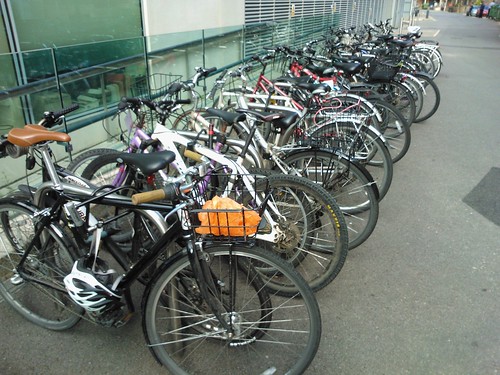 |
| Cycle rack in Oxford |
We have been visiting a friend in Oxford, and I have been impressed as usual by the genuine cycling culture that exists there. Bike shops everywhere, bikes everywhere, hire bikes available everywhere. Even out of term and without the critical mass that must be provided by the students, it was still a vibrant and delightful scene.
The sight above, just a typical rack in a back-lot, is nothing unusual for Oxford, even though it would be unheard of in Cardiff if there were no students around. But I was interested in a particularly geeky and anoraky fact after I made a quick study of the form. Not a single bike here had a fully enclosed chain. Not one had a hub brake. Not a single hub dynamo, or any other form of non-battery lighting. Only one of all the bikes here had hub gears.
There is a lot of terraced housing in Oxford. For the first time, I have seen front gardens turned into bike parking areas with cycle racks, which is a welcome change from being turned into a car park as is the norm in other cities. There are lots of student flats and student accommodation. In other words, bikes are stored outside day and night. I would have thought therefore that basic bike practicalities and functionalities such as the enclosed chain and hub brakes I mentioned above would have impacted on what is available for sale in the myriad of bike shops, or perhaps coloured the advice that new students are given when purchasing their new steed. But apparently not yet.
We may be seeing the re-emergence of "utility cycle culture" (that sounds frightening) here again in the UK, but are the manufacturers and retailers keeping pace? They seem to be able to follow the fixie trend well enough for instance, so why can't they make practical features more normal as they are in other countries? Perhaps the mountain bike aesthetic that kept so many small retailers going throughout the wilderness years is too hard to shake off? Perhaps the costs of things like hub brakes mean bikes jump out of an acceptable price range? Perhaps the customers have not yet learned to demand these things? I'm not sure, but it will be interesting to see how the trends develop and how the manufacturers and retailers react, or if they choose to lead instead.

Hi Toby! I'm Richard the cycle touring piano tuner you met at Louie's birthday in London.
ReplyDeleteI'm smiling and nodding as I read a few of your blog entries - I've lived and cycled in Oxford for ten years and London almost as long so I too have a thing or two to say about the infrastructure (or often about the lack of it), although I know nothing about town planning so maybe I have a very one-sided view...
Oxford is a great place to cycle, the nearer you get to the city centre the more authority you feel on your bike over the motor vehicles. It takes five minutes to get from my parents' house in Marston to the city centre but perhaps fifteen by car at certain times of day, and even if you get there you can't park a car anywhere. It's great!
There are some nice cycle routes around the city so I'm amazed at the huge number of people who still queue for an hour to roll their motor cars into Oxford every morning from nearby towns and villages - only the odd cyclist whizzing past them with a big grin. I don't understand how they can do the same thing day in and day out. A typical example is the daily traffic jam from Kidlington into Oxford - it's only a twenty minute bike ride to Oxford centre and there's a cycle route all the way, but I could count the number of cyclists on my fingers and toes.
The cycle routes do annoy me in places - for example Botley Road in West Oxford or the A4 in West London. Like many other cycle routes in this country they're on the pavement next to the road, and they stop and give way on every single little side street. The result is that most of the regular cycle commuters get frustrated with all the stop-starting and use the main road instead - even the dual carriageway of the A4. It seems to me that the transport planners may have had the best of intentions but no experience of actually cycling to work.
I gave up on those busy roads a while back, both in Oxford and London I now go more slowly, use the riverside paths, back streets, and take an extra half an hour to get across town - stress-free time well spent.
Hey Richard, thanks for stopping by. I'm glad the things we are saying resonate with you and chime with your experience. The thing that is interesting to me is that the cycling culture in Oxford is amazing DESPITE the crappy conditions. Imagine if there were Copenhagen style cycle routes with priority at junctions and "green wave" traffic lights to suit the pace of cyclists? It would be extraordinary. The engineers and planners in the UK need to get themselves over the The Netherlands and check it out - they solved this problem 20 years ago or more, and now have a superb nationwide infrastructure system.
DeleteKeep up the wrting, It really is good stuff and very enoyable (if a little frightening) too.
Living in Oxford, I've noticed the same thing. I bought myself a good commuting bike wanderingdanny.com/oxford/2013/07/kettler-spirit-city-bike-review/ and am surprised there are so few similar bikes on the roads.
ReplyDelete